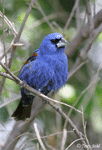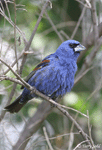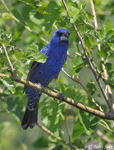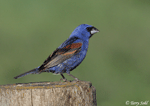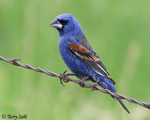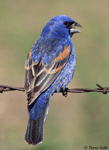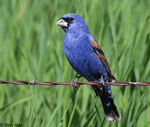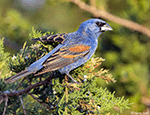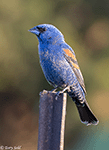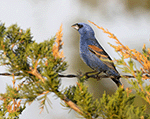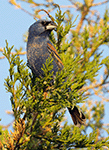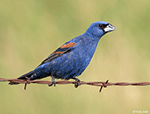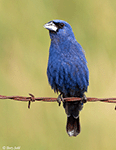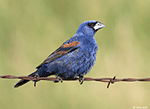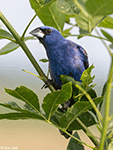| Length: 7 inches | Wingspan: 11 inches | Seasonality: Summer |
| ID Keys: Extremely thick bill, rust-colored wing-bars, dark blue body (male). Females warm brown all over. | ||
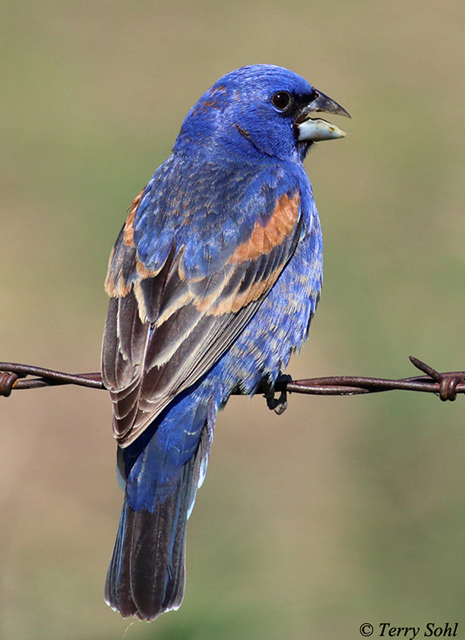 The Blue Grosbeak is a
denizen of thickets and other patches of vegetation in semi-open areas.
South Dakota is on the northern fringe of its breeding range, and Blue Grosbeaks
are generally the most common in the southern part of the state. Like many
species, they have expanded their range to the north in recent decades, likely
in response to a changing climate.It is distinguished from the similar Indigo
Bunting by its larger size, larger and thicker bill, and rust-colored wing-bars.
Females lack any blue coloring, with a warm brown coloring overall, but they
share the large chunky bill.
The Blue Grosbeak is a
denizen of thickets and other patches of vegetation in semi-open areas.
South Dakota is on the northern fringe of its breeding range, and Blue Grosbeaks
are generally the most common in the southern part of the state. Like many
species, they have expanded their range to the north in recent decades, likely
in response to a changing climate.It is distinguished from the similar Indigo
Bunting by its larger size, larger and thicker bill, and rust-colored wing-bars.
Females lack any blue coloring, with a warm brown coloring overall, but they
share the large chunky bill.
Habitat:
Prefers brushy low growth for breeding, preferably in semi-open country. This can include fence lines, brushy fields, streamside thickets, hedgerows, and woodland edges. They are often seen foraging along fence lines in South Dakota, dashing into nearby cover when flushed.
Diet:
The summer diet consists of many insects and spiders, as well as seeds and occasionally snails. The winter diet consists of a greater proportion of seeds and waste grain, along with insects.
Behavior:
Does much of its foraging on the ground, grabbing insects and seeds from the ground or from nearby foliage, or flying up to capture insects stirred up by its movements. They will also forage in brush and undergrowth, and low in trees.
Nesting:
June through August in South Dakota, with nesting sometimes lasting later into the summer than for many passerines. The nest of a Blue Grosbeak is placed low in a shrub or small tree, typically within 8 feet of the ground. The nest itself is a cup constructed of weeds, twigs, roots, strips of bark, and other vegetative material that may be available. They will also sometimes use manmade materials such as string or cloth. The female lays between 3 and 5 eggs, and she alone incubates them. The young hatch after only 12-13 days, and fledge from the nest after 10-14 days. Given their preference for semi-open habitats, they are a very frequent victim of Brown-headed Cowbird parasitism.
Song:
The song of a male Blue Grosbeak is a musical warbling, while they also have multiple buzzy or metallic calls.
- Click here to hear the song of a Blue Grosbeak1
- Click here to hear a call of a Blue Grosbeak as it since on a fence line2
- Click here to hear the chink and buzzy calls of a male Blue Grosbeak3
Migration:
Summers throughout much of the southern three-fourths of the U.S. Winters in Mexico and southward into South America.
Interactive eBird Map:
Click to access an interactive eBird map of Blue Grosbeak sightings
Similar Species:
Blue Grosbeak are structured differently, but with their bluer than blue (not sadder than sad!!) plumage, they could potentially be confused with the following two bunting species (click here for more ID tips for these birds).
- Indigo Bunting - Indigo Buntings, like Blue Grosbeaks, are summer visitors to South Dakota. Their habitat preferences are a little different, with Blue Grosbeaks typically liking shrubby areas in open country, and Indigo Buntings preferring a little more forest cover, but they are sometimes found in the same "edge" habitats. Indigo Buntings are smaller than Blue Grosbeaks, with a much smaller bill than the large, robust bill of a Blue Grosbeak. The blue on a male Indigo Bunting is a little different tone (touch lighter?) than that of a Blue Grosbeak, and they lack the rusty wing patches of a Blue Grosbeak. Females of the two species are also similar, but again, overall size and bill structure are diagnostic.
- Lazuli Bunting. - Lazuli Buntings are primarily found in western South Dakota. They are smaller than Blue Grosbeaks and have smaller bills. Male Lazuli Buntings are a sky blue (deeper blue on male Blue Grosbeak), and have light underparts with a buffy chest (all blue on a Blue Grosbeak). Lazuli Bunting males also have white/buff wing bars, as opposed to the chestnut-colored ones on a Blue Grosbeak male. Female Lazuli Buntings are again smaller than female Blue Grosbeaks, with a smaller bill, but they also have a paler, buffy underside compared to the more even brown tones on the plumage of a female Blue Grosbeak.
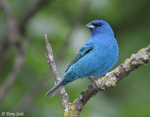 |
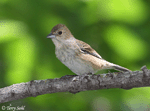 |
 |
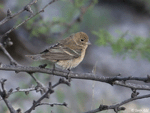 |
| Indigo Bunting (male) | Indigo Bunting (female) | Lazuli Bunting (male) | Lazuli Bunting (female) |
Bird Feeders:
Will attend feeders for many seeds and grains.
Conservation Status:
Breeding populations have expanded northward recently. There are also some indications that they've increased in numbers throughout much of their historical range. The IUCN currently considers the Blue Grosbeak to be a species of "least concern".
Further Information:
- Patuxent Bird Identification InfoCenter, Blue Grosbeak
- WhatBird - Blue Grosbeak
- Audubon Guide - Blue Grosbeak
Photo Information:
May 30th, 2015 - Kingsbury County, South Dakota - Terry Sohl
Additional Photos:
Click on the image chips or text links below for additional, higher-resolution Blue Grosbeak photos.
Audio File Credits:
- 1Manuel Grosselet, XC428726. Accessible at www.xeno-canto.org/428726
- 2Jerald R, XC327255. Accessible at www.xeno-canto.org/327255
- 3Andrew Spencer, XC33603. Accessible at www.xeno-canto.org/33603
| Click on the map below for a higher-resolution view |
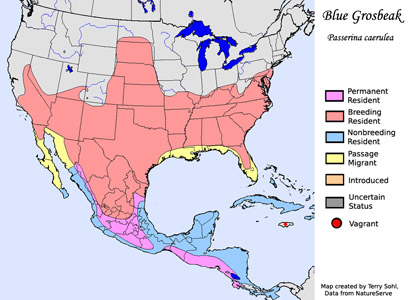 |
| South Dakota Status: Uncommon summer resident in the southern part of the state, rare in the north. |
Additional Blue Grosbeak Photos
Click for a higher-resolution version of these photos
